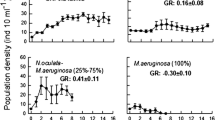Abstract
The accumulation ofMicrocystis aeruginosa hepatotoxins (microcystin-LR) in the phantom midge larvaChaoborus was studied in a 16 d laboratory experiment. In the cyanobacteria treatment,Chaoborus larvae were fed withDaphnia pulex juveniles which had been feeding for two days on a mixture ofScenedesmus obtusiusculus and toxicMicrocystis aeruginosa. In the control treatment theChaoborus larvae were offeredD. pulex raised onScenedesmus only. An HPLC analysis failed to detect any cyanobacteria toxin in theChaoborus larvae, indicating that the toxin was metabolized or excreted byD. pulex andChaoborus. There was a statistically significant increase in mortality of larvae in the cyanobacteria treatment, but no difference between treatments in pupation success ofChaoborus was observed.
Similar content being viewed by others
References
Carmichael, W. W., N. A. Mahmood & E. G. Hyde, 1990. Natural toxins from cyanobacteria (blue-green algae). In S. Hall & G. Strichartz (eds), Marine toxins: origin, structure and molecular pharmacology. Am. Chem. Soc. Symp. Ser. No. 418: 87–106.
Cohen, P., 1989. The structure and regulation of protein phosphatases. Annu. Rev. Biochem. 58: 453–508.
DeMott, W. R. & W. C. Kerfoot, 1982. Competition among cladocerans: nature of the interaction betweenBosmina andDaphnia. Ecology 63: 1949–1966.
DeMott, W. R. & F. Moxter, 1991. Foraging on cyanobacteria by copepods: responses to chemical defenses and resource abundance. Ecology 72: 1820–1834.
DeMott, W. R., Q.-X. Zhang & W. W. Carmichael, 1991. Effects of toxic cyanobacteria and purified toxins on the survival and feeding of a copepod and three species ofDaphnia. Limnol. Oceanogr. 36: 1346–1357.
Eriksson, J. E., J. A. O. Meriluoto & T. Lindholm, 1989. Accumulation of a peptide toxin from the cyanobacteriumOscillatoria agardhii in the freshwater musselAnodonta cygnea. Hydrobiologia 183: 211–216.
Fujiki, H. & M. Suganuma, 1993. Tumor promotion by inhibitors of protein phosphatases 1 and 2A: the okadaic acid class of compounds. Adv. Cancer Res. 61: 143–194.
Fulton, R. S. III & H. W. Pearl, 1987. Toxic and inhibitory effects of the blue-green algaMicrocystis aeruginosa on herbivorous zooplankton. J. Plankton Res. 9: 837–855.
Havel, J. E. & S. I. Dodson, 1987. Reproductive costs ofChaoborus-induced polymorphism inDaphnia pulex. Hydrobiologia 150: 273–281.
Honkanen, R. E., J. Zwiller, R. E. Moore, S. L. Daily, B. S. Khatra, M. Dukelow & A. L. Boynton, 1990. Characterization of microcystin-LR, a potent inhibitor of type 1 and type 2A protein phosphatases. J. Biol. Chem. 265: 19401–19494.
Kiviranta, J., K. Sivonen, K. Lahti, R. Luukkainen & S. I. Niemelä, 1991. Production and biodegradation of cyanobacterial toxins — a laboratory study. Arch. Hydrobiol. 121: 281–293.
Kiviranta, J., 1992. Larvicidal effects of toxic cyanobacteria on yellow fever mosquito,Aedes aegypti. Acta Pharm. Fenn. 101: 105–109.
Kiviranta, J., A. Abdel-Hameed, K. Sivonen, S. I. Niemelä & G. Carlberg, 1993. Toxicity of cyanobacteria to mosquito larvae — screening of active compounds. Envir. Toxicol. Wat. Qual. 8: 63–71.
Lampert, W., 1981. Toxicity of the blue-greenMicrocystis aeruginosa: Effective defence mechanism against grazing pressure byDaphnia. Verh. int. Ver. Limnol. 21: 1436–1440.
Lampert, W., 1982. Further studies on the inhibitory effect of the toxic blue-greenMicrocystis aeruginosa on the filtering rate of zooplankton. Arch. Hydrobiol. 95: 207–220.
Meriluoto, J. A. O., J. E. Eriksson, K. I. Harada, A. M. Dahlem, K. Sivonen & W. W. Carmichael, 1990. Internal surface reversed-phase high-performance liquid chromatographic separation of the cyanobacterial peptide toxins Microcystin-LA,-LR, -YR, -RR and nodularin. J. Chromatogr. 509: 390–395.
Mort, M. 1986.Chaoborus predation and the function of phenotypic variation inDaphnia. Hydrobiologia 133: 39–44.
Nizan, S., C. Dimentman & M. Shilo, 1986. Acute toxic effects of the cyanobacteriumMicrocystis aeruginosa onDaphnia magna. Limnol. Oceanogr. 31: 497–502.
Reinikainen, M., M. Ketola & M. Walls, 1994. Effects of the concentrations of toxicMicrocystis aeruginosa and an alternative food on the survival ofDaphnia pulex. Limnol. Oceanogr. 39: 424–432.
Sivonen, K., I. Niemelä, R. M. Niemi, L. Lepistö, T. H. Luoma & L. A. Räsänen. 1990. Toxic cyanobacteria in Finnish fresh and coastal waters. Hydrobiologia 190: 267–275.
Terriere, L. C., 1984. Induction of detoxication enzymes in insects. Annu. Rev. Ent. 29: 71–88.
Turell, M. J. & J. L. Middlebrook, 1988. Mosquito inoculation, an alternative bioassay for toxins. Toxicon 26: 1089–1094.
Walls, M. & M. Ketola, 1989. Effects of predator induced spines on individual fitness inDaphnia pulex. Limnol. Oceanogr. 34: 390–396.
Walls, M., H. Caswell & M. Ketola, 1991. Demographic costs ofChaoborus-induced defences inDaphnia pulex: a sensitivity analysis. Oecologia 87: 43–50.
Watanabe, M. M., K. Kaya & N. Takamura, 1992. Fate of the toxic cyclic heptapeptides, the microcystins, from blooms ofMicrocystis (Cyanobacteria) in a hypertrophic lake. J. Phycol. 28: 761–767.
Author information
Authors and Affiliations
Rights and permissions
About this article
Cite this article
Laurén-Määttä, C., Hietala, J., Reinikainen, M. et al. DoMicrocystis aeruginosa toxins accumulate in the food web: a laboratory study. Hydrobiologia 304, 23–27 (1995). https://doi.org/10.1007/BF02530700
Received:
Accepted:
Issue Date:
DOI: https://doi.org/10.1007/BF02530700




